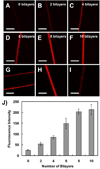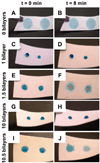Functionalization of fibers using azlactone-containing polymers: layer-by-layer fabrication of reactive thin films on the surfaces of hair and cellulose-based materials
- PMID: 20402471
- PMCID: PMC2877158
- DOI: 10.1021/am1000882
Functionalization of fibers using azlactone-containing polymers: layer-by-layer fabrication of reactive thin films on the surfaces of hair and cellulose-based materials
Abstract
We report an approach to the functionalization of fibers and fiber-based materials that is based on the deposition of reactive azlactone-functionalized polymers and the "reactive" layer-by-layer assembly of azlactone-containing thin films. We demonstrate (i) that the azlactone-functionalized polymer poly(2-vinyl-4,4-dimethylazlactone) (PVDMA) can be used to modify the surfaces of a model protein-based fiber (horsehair) and cellulose-based materials (e.g., cotton and paper), and (ii) that fibers functionalized in this manner can be used to support the fabrication of covalently cross-linked and reactive polymer multilayers assembled using PVDMA and poly(ethyleneimine) (PEI). The growth, chemical reactivity, and uniformity of films deposited on these substrates were characterized using fluorescence microscopy, confocal microscopy, and scanning electron microscopy (SEM). In addition to the direct functionalization of fibers, we demonstrate that the residual azlactone functionality in PVDMA-treated or film-coated fibers can be exploited to chemically modify the surface chemistry and physicochemical properties of fiber-based materials postfabrication using amine functionalized molecules. For example, we demonstrate that this approach permits control over the surface properties of paper (e.g., absorption of water) by simple postfabrication treatment of film-coated paper with the hydrophobic amine n-decylamine. The azlactone functionality present in these materials provides a platform for the modification of polymer-treated and film-coated fibers with a broad range of other chemical and biological species (e.g., enzymes, peptides, catalysts, etc.). The results of this investigation thus provide a basis for the functionalization of fibers and fiber-based materials (e.g., textile fabrics or nonwoven mats) of potential utility in a broad range of consumer, industrial, and biomedical contexts.
Figures





Similar articles
-
Free-standing and reactive thin films fabricated by covalent layer-by-layer assembly and subsequent lift-off of azlactone-containing polymer multilayers.Langmuir. 2010 Oct 19;26(20):16134-40. doi: 10.1021/la103009a. Langmuir. 2010. PMID: 20857952 Free PMC article.
-
Degradable Amine-Reactive Coatings Fabricated by the Covalent Layer-by-Layer Assembly of Poly(2-vinyl-4,4-dimethylazlactone) with Degradable Polyamine Building Blocks.Biomacromolecules. 2016 Sep 12;17(9):3067-75. doi: 10.1021/acs.biomac.6b00975. Epub 2016 Aug 30. Biomacromolecules. 2016. PMID: 27525718
-
Superhydrophobic Thin Films Fabricated by Reactive Layer-by-Layer Assembly of Azlactone-Functionalized Polymers.Chem Mater. 2010 Sep 11;22(23):6319-6327. doi: 10.1021/cm102115e. Chem Mater. 2010. PMID: 21151704 Free PMC article.
-
Melding Vapor-Phase Organic Chemistry and Textile Manufacturing To Produce Wearable Electronics.Acc Chem Res. 2018 Apr 17;51(4):850-859. doi: 10.1021/acs.accounts.7b00604. Epub 2018 Mar 9. Acc Chem Res. 2018. PMID: 29521501 Review.
-
Processing and characterization of natural cellulose fibers/thermoset polymer composites.Carbohydr Polym. 2014 Aug 30;109:102-17. doi: 10.1016/j.carbpol.2014.03.039. Epub 2014 Mar 28. Carbohydr Polym. 2014. PMID: 24815407 Review.
Cited by
-
The influence of biomimetic topographical features and the extracellular matrix peptide RGD on human corneal epithelial contact guidance.Acta Biomater. 2013 Feb;9(2):5040-51. doi: 10.1016/j.actbio.2012.10.007. Epub 2012 Oct 13. Acta Biomater. 2013. PMID: 23069317 Free PMC article.
-
Postpolymerization Modification of Poly(2-vinyl-4,4-dimethyl azlactone) as a Versatile Strategy for Drug Conjugation and Stimuli-Responsive Release.Biomacromolecules. 2024 Apr 8;25(4):2621-2634. doi: 10.1021/acs.biomac.4c00181. Epub 2024 Mar 8. Biomacromolecules. 2024. PMID: 38457653 Free PMC article.
-
Functionalization of reactive polymer multilayers with RGD and an antifouling motif: RGD density provides control over human corneal epithelial cell-substrate interactions.J Biomed Mater Res A. 2012 Jan;100(1):84-93. doi: 10.1002/jbm.a.33233. Epub 2011 Oct 4. J Biomed Mater Res A. 2012. PMID: 21972074 Free PMC article.
-
Free-standing and reactive thin films fabricated by covalent layer-by-layer assembly and subsequent lift-off of azlactone-containing polymer multilayers.Langmuir. 2010 Oct 19;26(20):16134-40. doi: 10.1021/la103009a. Langmuir. 2010. PMID: 20857952 Free PMC article.
-
Azlactone-Functionalized Polymers as Reactive Platforms for the Design of Advanced Materials: Progress in the Last Ten Years.Polym Chem. 2012 Jan 1;3(1):66-80. doi: 10.1039/C1PY00314C. Epub 2011 Oct 12. Polym Chem. 2012. PMID: 29492112 Free PMC article.
References
-
- Mahltig B, Textor T. Nanosols and Textiles. Hackensack: World Scientific Publishing Co. Pte. Ltd.; 2008.
-
- Qi KH, Daoud WA, Xin JH, Mak CL, Tang WZ, Cheung WP. J. Mater. Chem. 2006;16:4567–4574.
-
- Krogman KC, Zacharia NS, Grillo DM, Hammond PT. Chem. Mater. 2008;20:1924–1930.
-
- Abidi N, Cabrales L, Hequet E. ACS Appl. Mater. Interfaces. 2009;1:2141–2146. - PubMed
-
- Krogman KC, Lowery JL, Zacharia NS, Rutledge GC, Hammond PT. Nat. Mater. 2009;8:512–518. - PubMed
Publication types
MeSH terms
Substances
Grants and funding
LinkOut - more resources
Full Text Sources
Other Literature Sources

